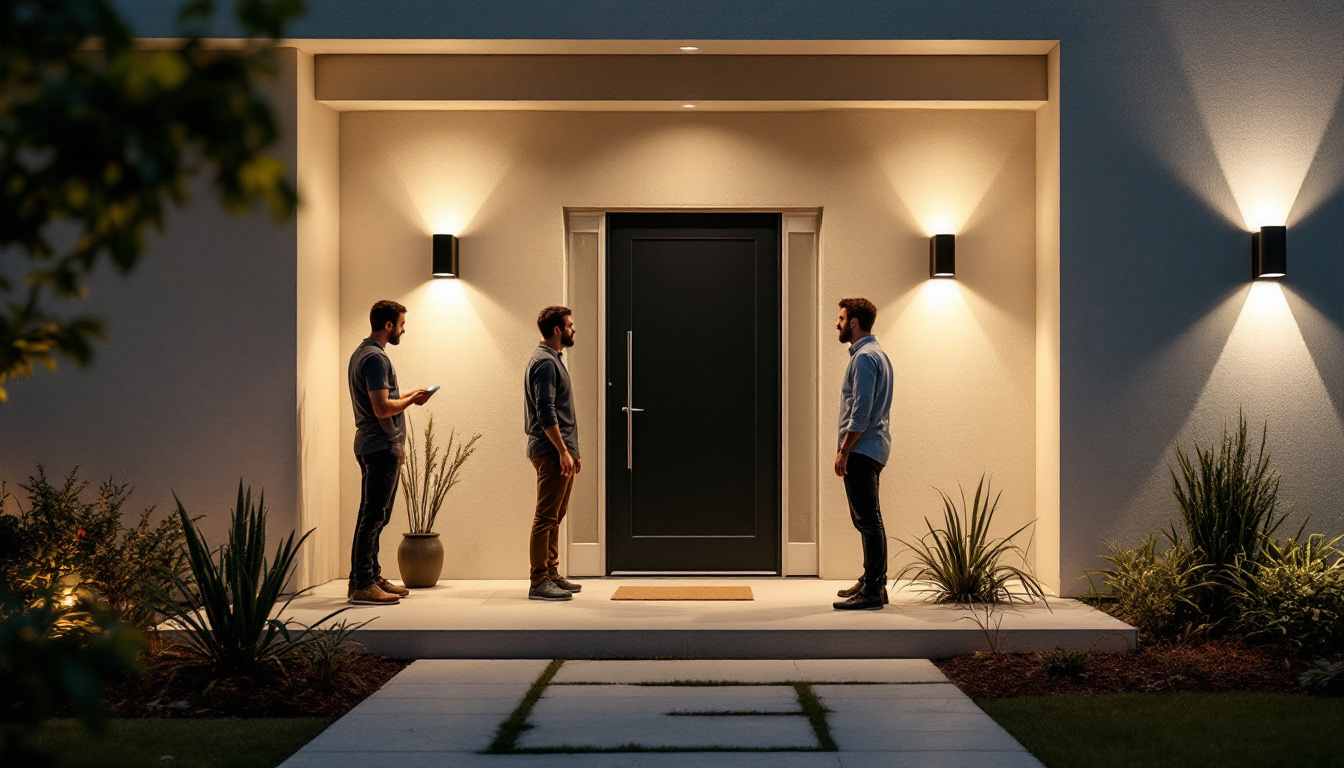
outdoor lighting plays a crucial role in enhancing the safety, security, and aesthetic appeal of residential and commercial properties. It is not merely about illuminating pathways or highlighting architectural features; it also serves to create a welcoming atmosphere. As a lighting contractor, understanding the multifaceted benefits of outdoor lighting is essential for training your team effectively.
Effective outdoor lighting design can deter criminal activity, reduce accidents, and improve the overall ambiance of a space. When your team is well-trained in these aspects, they can provide valuable insights to clients, ensuring that the lighting solutions offered are both functional and visually appealing.
One of the primary functions of outdoor lighting is to enhance safety and security. Well-lit areas discourage potential intruders and reduce the likelihood of accidents. Training your team to recognize the best practices for placing lights in high-traffic and vulnerable areas is vital. This includes entry points, driveways, and walkways.
Incorporating motion sensors and timers can also be a part of the training. These features not only save energy but also provide an added layer of security by ensuring that lights are activated when needed. Your team should understand how to recommend these features to clients, emphasizing their importance in creating a secure environment.
Moreover, educating your team about the latest advancements in smart outdoor lighting technology can further enhance security measures. For instance, integrating outdoor lighting systems with home security cameras and alarms can provide a comprehensive safety solution. This interconnected approach not only offers peace of mind to homeowners but also positions your team as knowledgeable experts in the field, capable of providing cutting-edge solutions that align with modern security needs.
Outdoor lighting is not just about safety; it also enhances the visual appeal of a property. Training your team to understand the principles of design, such as balance, contrast, and harmony, will enable them to create stunning lighting schemes that complement the architecture and landscape of a property.
Encourage your team to explore various lighting techniques, such as uplighting, downlighting, and moonlighting. Each technique serves a different purpose and can dramatically change the atmosphere of a space. Understanding these techniques will empower your team to provide tailored solutions that meet client preferences and needs.
Additionally, your team should be well-versed in the seasonal variations of outdoor lighting. For example, during the winter months, warm, inviting lights can create a cozy ambiance, while brighter, cooler lights may be more suitable for summer gatherings. By recognizing these seasonal trends, your team can suggest appropriate lighting solutions that enhance the outdoor experience year-round, ensuring that clients’ properties are not only functional but also visually captivating in every season.
To train your team effectively, it’s essential to cover the fundamental components of outdoor lighting design. This knowledge will equip them to tackle various projects with confidence and creativity.
There are several types of outdoor lighting fixtures, each serving a unique purpose. Training should include a comprehensive overview of these fixtures, including path lights, wall sconces, floodlights, and spotlights. Understanding the specific applications and benefits of each type will enable your team to make informed recommendations to clients.
For instance, path lights are excellent for illuminating walkways, while floodlights can provide broad coverage for larger areas. By familiarizing your team with these fixtures, they can better assess client needs and suggest appropriate solutions.
Different lighting techniques can dramatically alter the perception of a space. Training should cover techniques such as accent lighting, which highlights specific features, and ambient lighting, which provides overall illumination. Your team should be able to explain the benefits of each technique to clients, helping them understand how to achieve their desired effects.
Additionally, incorporating techniques like layering light can enhance the overall design. This involves combining different types of lighting to create depth and interest. Training your team in these techniques will ensure they can create dynamic and engaging outdoor environments.
With the growing emphasis on sustainability, it is crucial for your team to be knowledgeable about energy-efficient lighting options. Training should include information on LED technology, solar-powered fixtures, and smart lighting systems. Understanding the benefits of these options will allow your team to promote sustainable practices to clients.
Moreover, educating your team about the long-term cost savings associated with energy-efficient lighting can be a powerful selling point. Clients are increasingly interested in reducing their carbon footprint, and your team should be prepared to provide solutions that align with this goal.
Training your team in outdoor lighting design requires a multifaceted approach. Utilizing various training methods can enhance engagement and retention of information.
Hands-on workshops are an effective way to provide practical experience. Organizing sessions where your team can work with different lighting fixtures and techniques will help solidify their understanding. These workshops can include real-life scenarios where team members can design lighting plans for specific properties.
Encouraging collaboration during these workshops can also foster teamwork and creativity. By working together, team members can share ideas and learn from each other, ultimately enhancing their skills and confidence in outdoor lighting design.
In addition to hands-on workshops, online training resources can be invaluable. Providing access to webinars, tutorials, and industry articles allows your team to learn at their own pace. This flexibility can be particularly beneficial for busy schedules, ensuring that team members can continue their education without disrupting their work.
Encouraging your team to engage with online communities and forums can also provide additional insights and support. These platforms often feature discussions on the latest trends and technologies in outdoor lighting, keeping your team informed and up-to-date.
Implementing mentorship programs can further enhance training efforts. Pairing less experienced team members with seasoned professionals allows for knowledge transfer and personalized guidance. Mentors can share their experiences, offer advice, and provide feedback on design ideas, helping to nurture the next generation of lighting experts.
This approach not only strengthens skills but also fosters a sense of camaraderie within the team. Building relationships among team members can lead to a more collaborative and innovative work environment.
Training your team in outdoor lighting design extends beyond technical skills. Effective communication and relationship-building are equally important. Your team should be equipped to engage with clients confidently and professionally.
One of the first steps in any project is understanding the client’s needs and preferences. Training should focus on active listening skills, enabling team members to ask the right questions and gather essential information. This understanding will serve as the foundation for creating tailored lighting solutions that meet client expectations.
Encouraging team members to take notes during client meetings can also be beneficial. This practice ensures that important details are not overlooked and demonstrates to clients that their input is valued.
Once your team has gathered information, the next step is presenting solutions effectively. Training should include tips on creating compelling presentations that highlight the benefits of proposed lighting designs. Visual aids, such as renderings or mood boards, can help clients visualize the final outcome.
Moreover, team members should be trained to address potential concerns or objections from clients. This preparation will enable them to navigate discussions confidently and reassure clients about their choices.
Building long-term relationships with clients is essential for repeat business and referrals. Training should emphasize the importance of follow-up communication after project completion. Encouraging team members to check in with clients to ensure satisfaction demonstrates commitment and professionalism.
Additionally, providing ongoing support and maintenance services can further solidify these relationships. Clients are more likely to return for future projects if they feel valued and supported throughout the entire process.
The lighting industry is constantly evolving, with new technologies and design trends emerging regularly. Training your team to stay informed about these changes is crucial for maintaining a competitive edge.
Encouraging team members to attend trade shows and conferences can provide valuable insights into the latest products and innovations. These events often feature workshops and seminars led by industry experts, offering opportunities for professional development.
Moreover, networking with other professionals can lead to collaborations and partnerships that can benefit your business. Staying connected with industry peers allows your team to share knowledge and best practices, further enhancing their skills.
Subscribing to industry publications and newsletters is another effective way to stay informed. These resources often feature articles on emerging trends, case studies, and expert opinions. Encouraging your team to read these materials regularly will help them remain knowledgeable and adaptable in a rapidly changing industry.
Additionally, discussing these publications during team meetings can foster a culture of continuous learning and collaboration. Sharing insights and discussing new ideas can spark creativity and innovation within your team.
Training your team in outdoor lighting design is a multifaceted process that encompasses technical skills, client communication, and industry awareness. By focusing on the importance of outdoor lighting, key components of design, effective training methods, and relationship-building strategies, your team will be well-equipped to provide exceptional service to clients.
Investing in your team’s education not only enhances their skills but also contributes to the overall success of your business. As the lighting industry continues to evolve, a well-trained team will be your greatest asset, ensuring that you remain competitive and capable of meeting the diverse needs of your clients.
Ready to elevate your outdoor lighting projects with the best in spec-grade lighting products? Look no further than LumenWholesale, where we provide contractors with exceptional quality at wholesale prices. Say goodbye to local distributor markups and hello to our extensive selection that meets the highest industry standards. With free shipping on bulk orders, you can trust that you’re getting premium lighting at the best value — all without hidden fees. Make your next project shine and experience the LumenWholesale difference today.

Discover effective strategies for lighting contractors to tackle common challenges in highbay lighting projects.

Discover the fascinating history of street lights and uncover how understanding their evolution can give lighting contractors a competitive edge in securing more bids.

Discover how LED lighting flush mounts are revolutionizing the work of lighting contractors by enhancing energy efficiency and design versatility.

Discover the latest trends in solar landscaping lights that every lighting contractor needs to know.